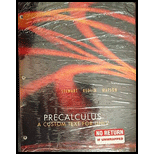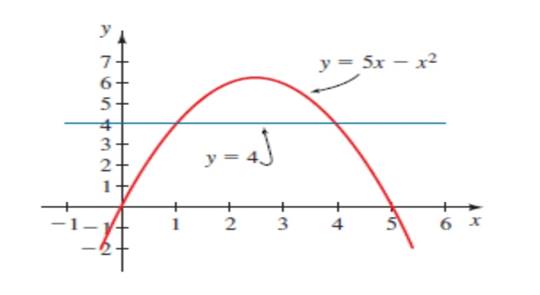
a.
To calculate: The equation

a.
Answer to Problem 4E
The solution of the equation
Explanation of Solution
Given information:
The equation
Formula used:
To the help of middle term factorisation method.
Steps to use this method to solve a quadratic polynomial
Step 1. Multiply the coefficient of
Step 2. Now to get the coefficient of
Step 3. Now we have 4 terms now, take common from 1st two terms and take common from another two common and from there two factors were come.
Step 3. Take either one bracket is equal to zero or another is equal to zero.
Step 4. Now the value of
Calculation:
The graph of the equation
So find the roots of the equation
Rewrite the equation:
Rearrange the equation in a polynomial form and take ‘-’ common from the equation:
Further simplify the equation:
Now to take common:
Either
Simplify further as:
The solution of the equation
b.
To calculate: The solution of the equations
b.
Answer to Problem 4E
The solution of the inequality
Explanation of Solution
Given information:
The inequality
Formula used:
To the help of middle term factorisation method.
Steps to use this method to solve a quadratic polynomial
Step 1. Multiply the coefficient of
Step 2. Now to get the coefficient of
Step 3. Now we have 4 terms now, take common from 1st two terms and take common from another two common and from there two factors were come.
Step 3. Take either one bracket is equal to zero or another is equal to zero.
Step 4. Now the value of
Calculation:
The inequality
So find the roots of the inequality
Rewrite the inequality:
Rearrange the equation in a polynomial form and take ‘-’ common from the equation:
Further simplify the equation:
Now to take common:
Either
Simplify further as:
Thus, the solution of the inequality
Chapter 1 Solutions
Precalculus - A Custom Text for UNLV
- = 5 37 A 4 8 0.5 06 9arrow_forwardConsider the following system of equations, Ax=b : x+2y+3z - w = 2 2x4z2w = 3 -x+6y+17z7w = 0 -9x-2y+13z7w = -14 a. Find the solution to the system. Write it as a parametric equation. You can use a computer to do the row reduction. b. What is a geometric description of the solution? Explain how you know. c. Write the solution in vector form? d. What is the solution to the homogeneous system, Ax=0?arrow_forward2. Find a matrix A with the following qualities a. A is 3 x 3. b. The matrix A is not lower triangular and is not upper triangular. c. At least one value in each row is not a 1, 2,-1, -2, or 0 d. A is invertible.arrow_forward
- Find the exact area inside r=2sin(2\theta ) and outside r=\sqrt(3)arrow_forwardA 20 foot ladder rests on level ground; its head (top) is against a vertical wall. The bottom of the ladder begins by being 12 feet from the wall but begins moving away at the rate of 0.1 feet per second. At what rate is the top of the ladder slipping down the wall? You may use a calculator.arrow_forwardExplain the focus and reasons for establishment of 12.4.1(root test) and 12.4.2(ratio test)arrow_forward
- Use 12.4.2 to determine whether the infinite series on the right side of equation 12.6.5, 12.6.6 and 12.6.7 converges for every real number x.arrow_forwarduse Cauchy Mean-Value Theorem to derive Corollary 12.6.2, and then derive 12.6.3arrow_forwardExplain the focus and reasons for establishment of 12.5.4arrow_forward
 Calculus: Early TranscendentalsCalculusISBN:9781285741550Author:James StewartPublisher:Cengage Learning
Calculus: Early TranscendentalsCalculusISBN:9781285741550Author:James StewartPublisher:Cengage Learning Thomas' Calculus (14th Edition)CalculusISBN:9780134438986Author:Joel R. Hass, Christopher E. Heil, Maurice D. WeirPublisher:PEARSON
Thomas' Calculus (14th Edition)CalculusISBN:9780134438986Author:Joel R. Hass, Christopher E. Heil, Maurice D. WeirPublisher:PEARSON Calculus: Early Transcendentals (3rd Edition)CalculusISBN:9780134763644Author:William L. Briggs, Lyle Cochran, Bernard Gillett, Eric SchulzPublisher:PEARSON
Calculus: Early Transcendentals (3rd Edition)CalculusISBN:9780134763644Author:William L. Briggs, Lyle Cochran, Bernard Gillett, Eric SchulzPublisher:PEARSON Calculus: Early TranscendentalsCalculusISBN:9781319050740Author:Jon Rogawski, Colin Adams, Robert FranzosaPublisher:W. H. Freeman
Calculus: Early TranscendentalsCalculusISBN:9781319050740Author:Jon Rogawski, Colin Adams, Robert FranzosaPublisher:W. H. Freeman
 Calculus: Early Transcendental FunctionsCalculusISBN:9781337552516Author:Ron Larson, Bruce H. EdwardsPublisher:Cengage Learning
Calculus: Early Transcendental FunctionsCalculusISBN:9781337552516Author:Ron Larson, Bruce H. EdwardsPublisher:Cengage Learning





